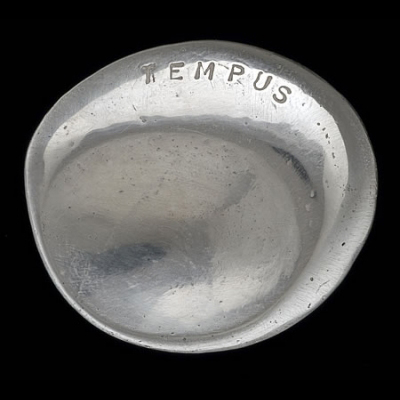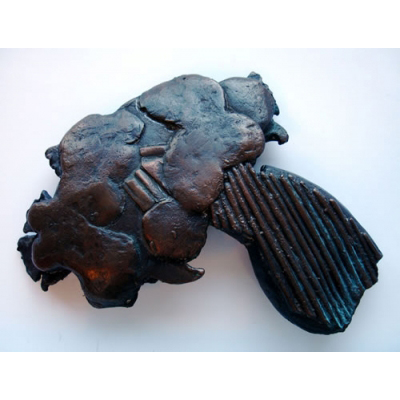Rob Wood is a sculptor living and working in Falmouth, in Cornwall. Having studied sculpture at Glasgow School of Art from 1975 to 1981, he went to work in the Department of Fine Art of Falmouth College of Arts in 1982. Periods of teaching at art colleges in Eastbourne and Portsmouth followed. In 1990 he became senior lecturer in sculpture at Falmouth, a position he still occupies. He has also acted as visiting lecturer at colleges in Brighton, Glasgow, Portsmouth, and Sofia, and has had residencies in the Netherlands, Switzerland, Denmark, and Sweden. Since 1981 he has had solo shows in Britain and several other European countries, and his work has also been seen in the United States. About his BAMS medal, Past and Present, Nancy Roth, lecturer in Art and Cultural Studies in the Department of Fine Art of Falmouth College of Arts, writes: ‘The two sides of the medal are magnets. Drawing metaphorically on the principle of a computer hard drive, they represent memory as infinitely changeable variations in a magnetic field. The attraction between the two sides is strong enough to hold small fragments of “memory” in place. Shaped like fragments of architectural ornament or details of a textile design, the detachable elements suggest images drawn in at the edges of awareness, perhaps in moments of reverie or distraction. They may have become memories serendipitously, rather than through deliberate purpose. In any case they now have taken on shape, substance, durability. The relationships among them, however, have not. With a decision and a little energy, it is possible to separate the sides, change the composition, reconfigure the fragments, reshape the whole. Of course such work is to be undertaken with sensitivity to aesthetic values as well as to structural needs of an object in relation to its environment. To insist on using all the steel elements at once, for example, will make the composition look cluttered and inaccessible. Rather there are decisions to be made and remade. The overall shape and visual appearance of the medal will be substantially affected by which elements are included or left out at any given moment, for example. There are further decisions concerning a balance, or symmetry between those placed inside and outside, about angles, shapes, rhythms in the visual relationships. The aesthetics of the text, its legibility and relative prominence, need consideration as well. ‘This kind of “memory work” should be done often, for the medal will respond to such attention. With frequent handling, the patina will become smoother and more reflective in comparison with the lowered surface that bears the text, bringing the two surfaces into sharper contrast. The text, that is, will appear more crisp and prominent. Taken from Marcel Proust’s A la recherche du temps perdu, the words divide into two nearly equal parts. The first mourns the irretrievable loss of one single, continuous past, its dissolution into fragments. The second celebrates the promise of rejoining the fragments in infinitely many possible ways.’

Past and Present
Past and Present
By: Rob Wood, 2001
Medium: bronze, steel and magnets
Size: 78mm
Cast by: the artist
Edition: 40




